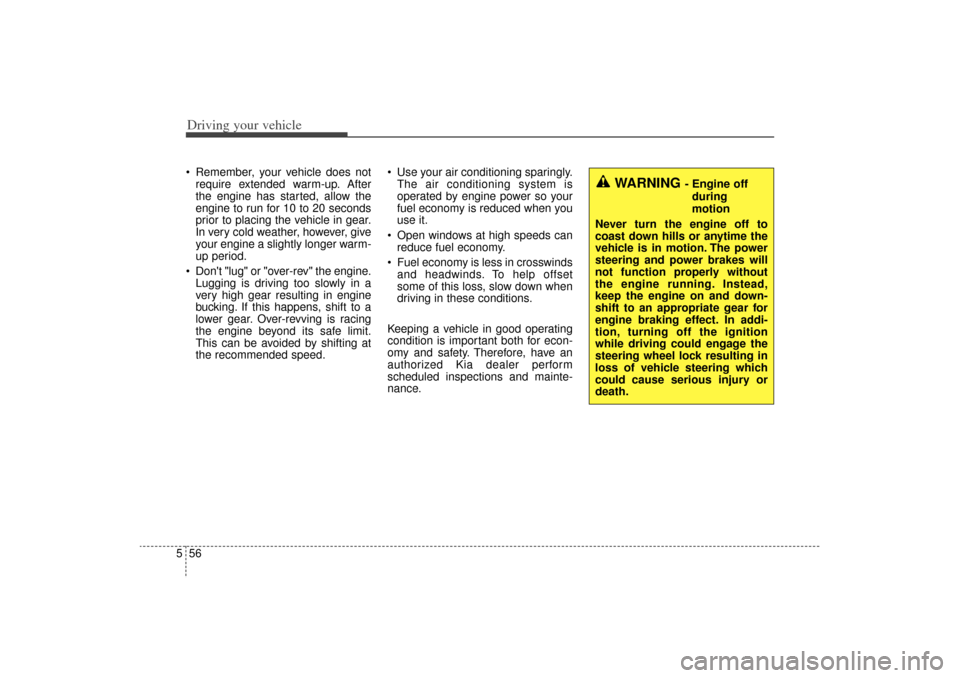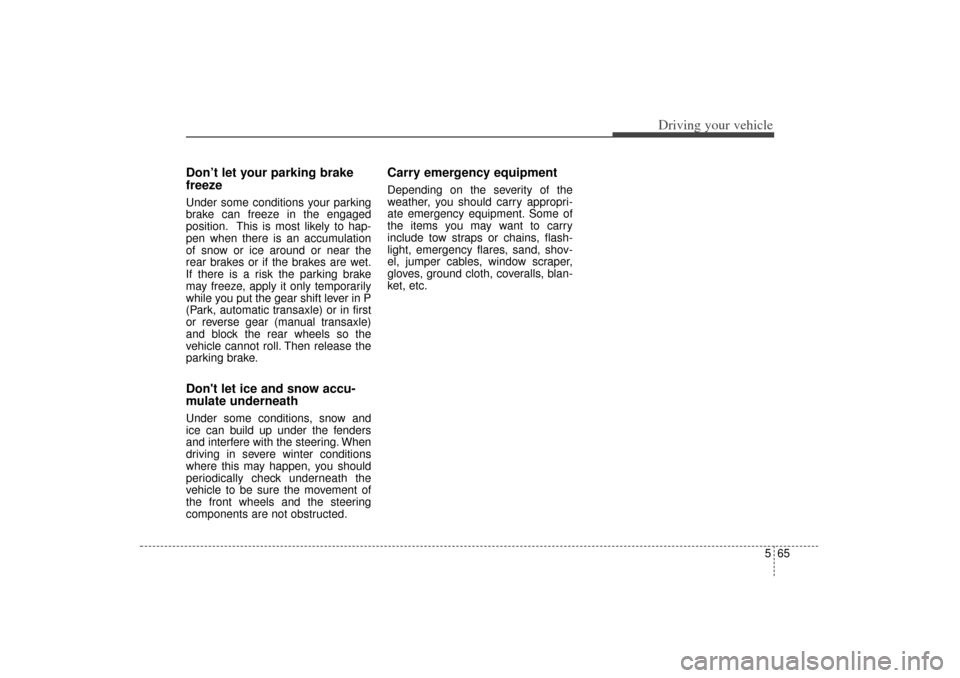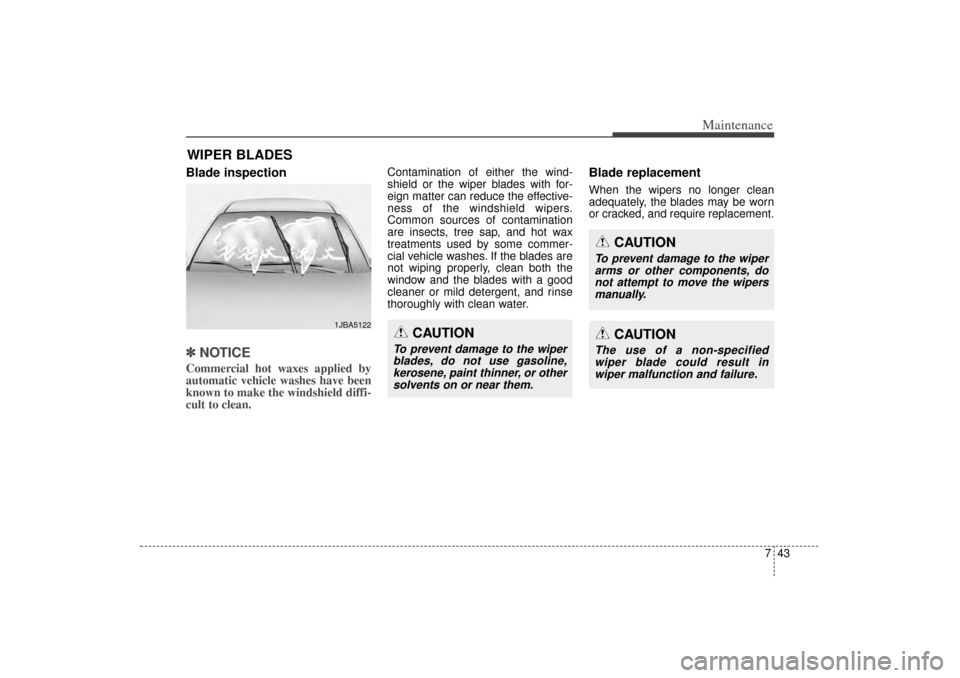Page 358 of 508

553
Driving your vehicle
Non-operating conditionDriver's AttentionThe driver must be cautious in the
following situations in which the sys-
tem may not assist the driver and
may not function properly.
- Curved roads, tollgates, etc.
- The surrounding of the sensor iscovered by rain, snow, mud, etc
- The rear bumper near the sensor is covered or hidden with a foreign
matter such as a sticker, bumper
guard, bicycle stand etc.
- The rear bumper is damaged or the sensor is out of place.
- The height of the vehicle is changed or altered such as when
the trunk is loaded with heavy
objects, or has abnormal tire pres-
sure etc.
- Due to bad weather such as heavy rain or snow.
- A fixed object is near such as a guardrail, etc. - A lot of amount of metal sub-
stances are near the vehicles such
as a construction area.
- A big vehicle is near such as a bus or truck.
- A motorcycle or bicycle is near.
- A flat trailer like vehicle is near.
- If the vehicle has started at the same time as the vehicle next to it
and has accelerated.
- When the other vehicle passes by very fast.
- When changing lanes.
- When going down or up a steep road where the height of the lane is
different.
- When the other vehicle drives at the rear very nearby or drives very
close.
- When the temperature near the bumper is high.
- When a trailer or carrier is installed.
Outside rearview mirror may not alert the driver when:- The outside rearview mirror hous- ing is covered with foreign matter.
- The window is covered with foreign matter.
- The windows are severely tinted.
XM(FL) CAN(ENG) 5.QXP 1/23/2013 3:31 PM Page 53
Page 361 of 508

Driving your vehicle56
5 Remember, your vehicle does not
require extended warm-up. After
the engine has started, allow the
engine to run for 10 to 20 seconds
prior to placing the vehicle in gear.
In very cold weather, however, give
your engine a slightly longer warm-
up period.
Don't "lug" or "over-rev" the engine. Lugging is driving too slowly in a
very high gear resulting in engine
bucking. If this happens, shift to a
lower gear. Over-revving is racing
the engine beyond its safe limit.
This can be avoided by shifting at
the recommended speed. Use your air conditioning sparingly.
The air conditioning system is
operated by engine power so your
fuel economy is reduced when you
use it.
Open windows at high speeds can reduce fuel economy.
Fuel economy is less in crosswinds and headwinds. To help offset
some of this loss, slow down when
driving in these conditions.
Keeping a vehicle in good operating
condition is important both for econ-
omy and safety. Therefore, have an
authorized Kia dealer perform
scheduled inspections and mainte-
nance.
WARNING
- Engine off during
motion
Never turn the engine off to
coast down hills or anytime the
vehicle is in motion. The power
steering and power brakes will
not function properly without
the engine running. Instead,
keep the engine on and down-
shift to an appropriate gear for
engine braking effect. In addi-
tion, turning off the ignition
while driving could engage the
steering wheel lock resulting in
loss of vehicle steering which
could cause serious injury or
death.
XM(FL) CAN(ENG) 5.QXP 1/23/2013 3:31 PM Page 56
Page 369 of 508

Driving your vehicle64
5Use high quality ethylene gly-
col coolantYour vehicle is delivered with high
quality ethylene glycol coolant in the
cooling system. It is the only type of
coolant that should be used because
it helps prevent corrosion in the cool-
ing system, lubricates the water
pump and prevents freezing. Be sure
to replace or replenish your coolant
in accordance with the maintenance
schedule in section 7. Before winter,
have your coolant tested to assure
that its freezing point is sufficient for
the temperatures anticipated during
the winter.Check battery and cablesWinter puts additional burdens on
the battery system. Visually inspect
the battery and cables as described
in section 7. The level of charge in
your battery can be checked by an
authorized Kia dealer or a service
station.
Change to "winter weight" oil
if necessaryIn some climates it is recommended
that a lower viscosity "winter weight"
oil be used during cold weather. See
section 8 for recommendations. If
you aren't sure what weight oil you
should use, consult an authorized
Kia dealer.Check spark plugs and igni-
tion systemInspect your spark plugs as
described in section 7 and replace
them if necessary. Also check all
ignition wiring and components to be
sure they are not cracked, worn or
damaged in any way.
To keep locks from freezingTo keep the locks from freezing,
squirt an approved de-icer fluid or
glycerine into the key opening. If a
lock is covered with ice, squirt it with
an approved de-icing fluid to remove
the ice. If the lock is frozen internally,
you may be able to thaw it out by
using a heated key. Handle the heat-
ed key with care to avoid injury.Use approved window washer
anti-freeze in systemTo keep the water in the window
washer system from freezing, add an
approved window washer anti-freeze
solution in accordance with instruc-
tions on the container. Window wash-
er anti-freeze is available from an
authorized Kia dealer and most auto
parts outlets. Do not use engine
coolant or other types of anti-freeze
as these may damage the paint fin-
ish.
XM(FL) CAN(ENG) 5.QXP 1/23/2013 3:31 PM Page 64
Page 370 of 508

565
Driving your vehicle
Don’t let your parking brake
freezeUnder some conditions your parking
brake can freeze in the engaged
position. This is most likely to hap-
pen when there is an accumulation
of snow or ice around or near the
rear brakes or if the brakes are wet.
If there is a risk the parking brake
may freeze, apply it only temporarily
while you put the gear shift lever in P
(Park, automatic transaxle) or in first
or reverse gear (manual transaxle)
and block the rear wheels so the
vehicle cannot roll. Then release the
parking brake.Don't let ice and snow accu-
mulate underneathUnder some conditions, snow and
ice can build up under the fenders
and interfere with the steering. When
driving in severe winter conditions
where this may happen, you should
periodically check underneath the
vehicle to be sure the movement of
the front wheels and the steering
components are not obstructed.
Carry emergency equipmentDepending on the severity of the
weather, you should carry appropri-
ate emergency equipment. Some of
the items you may want to carry
include tow straps or chains, flash-
light, emergency flares, sand, shov-
el, jumper cables, window scraper,
gloves, ground cloth, coveralls, blan-
ket, etc.
XM(FL) CAN(ENG) 5.QXP 1/23/2013 3:31 PM Page 65
Page 447 of 508

743
Maintenance
WIPER BLADES Blade inspection✽
✽NOTICECommercial hot waxes applied by
automatic vehicle washes have been
known to make the windshield diffi-
cult to clean.
Contamination of either the wind-
shield or the wiper blades with for-
eign matter can reduce the effective-
ness of the windshield wipers.
Common sources of contamination
are insects, tree sap, and hot wax
treatments used by some commer-
cial vehicle washes. If the blades are
not wiping properly, clean both the
window and the blades with a good
cleaner or mild detergent, and rinse
thoroughly with clean water.
Blade replacement When the wipers no longer clean
adequately, the blades may be worn
or cracked, and require replacement.
1JBA5122
CAUTION
To prevent damage to the wiper
blades, do not use gasoline,kerosene, paint thinner, or othersolvents on or near them.
CAUTION
To prevent damage to the wiperarms or other components, donot attempt to move the wipersmanually.
CAUTION
The use of a non-specifiedwiper blade could result inwiper malfunction and failure.
XM(FL) CAN(ENG) 7.QXP 1/23/2013 3:36 PM Page 43
Page 449 of 508
745
Maintenance
2. Lift up the wiper blade clip. Thenpull down the blade assembly and
remove it. 3. Install the new blade assembly in
the reverse order of removal.
Rear window wiper blade 1. Raise the wiper arm and pull outthe wiper blade assembly.
OHM078060
OHM078062
OHM078061
XM(FL) CAN(ENG) 7.QXP 1/23/2013 3:37 PM Page 45
Page 453 of 508

749
Maintenance
Reset itemsItems should be reset after the bat-
tery has been discharged or the bat-
tery has been disconnected.
Auto up/down window (See section 4)
Sunroof (See section 4)
Trip computer (See section 4)
Climate control system (See section 4)
Clock (See section 4)
Audio (See section 4)
WARNING
Before performing mainte- nance or recharging the bat-
tery, turn off all accessories
and stop the engine.
The negative battery cable must be removed first and
installed last when the battery
is disconnected.
WARNING
- Recharging
battery
When recharging the battery,
observe the following precau-
tions:
The battery must be removedfrom the vehicle and placed in
an area with good ventilation.
Do not allow cigarettes, sparks, or flame near the bat-
tery.
Watch the battery during charging, and stop or reduce
the charging rate if the battery
cells begin gassing (boiling)
violently or if the temperature
of the electrolyte of any cell
exceeds 49°C (120°F).
Wear eye protection when checking the battery during
charging.
Disconnect the battery charg- er in the following order.
(Continued)
(Continued)
1. Turn off the battery chargermain switch.
2. Unhook the negative clamp from the negative battery ter-
minal.
3. Unhook the positive clamp from the positive battery ter-
minal.
XM(FL) CAN(ENG) 7.QXP 1/23/2013 3:37 PM Page 49
Page 473 of 508

769
Maintenance
Inner fuse panel
Description Fuse ratingProtected component
MODULE 2 10AInstrument Cluster (IND./MICOM), Steering Angle Sensor, Alternator, Smart Key Control Module, A/V &
Navigation Head Unit, STOP_SW, SI_ECU, HLLD LH/RH
MODULE 1 7.5A SPORTS MODE SW/KEY_SOL, SPORT_MODE_SW
A/BAG IND 10A Instrument Cluster (IND.), Digital Clock
A/BAG 15A SRS Control Module, PODS Module
START 7.5A E/R Fuse & Relay Box (Relay - Start, Sub Start, Burglar Alarm), PDM
WIPER RR 15A ICM Relay Box (Rear Wiper Relay), Rear Wiper Motor, Multifunction Switch (Wiper)
WIPER FRT 25A E/R Fuse & Relay Box (Wiper (Low) Relay), Front Wiper Motor, Multifunction Switch (Wiper)
MODULE 3 10AESC Off Switch, Front A/C Control Module, Instrument Cluster, Audio, MTS, A/V & Navigation Head Unit,
Tire Pressure Monitoring Module, Power Window Main Switch, 4WD ECU, P_WDW_PASS_SW_IMS,
Rear Parking Assist SNSR, FRT_DRV_SEAT_EXT, FRT_PASS_SEAT_EXT, CONSOLE_EXTN , IPM
(BCM IG1)
A/CON 7.5AFront A/C Control Module, Active Incar Sensor, Cluster Ionize, ICM Relay Box (Rear A/C Relay) E/R
Fuse & Relay Box (Blower Relay)
AMP 30A AMP
P/OUTLET 1 15A -
P/OUTLET 2 20A LUGGAGE_POWER_OUTLET, FRT_POWER_OUTLET_DRV
BLOWER RR 20A ICM Relay Box (Rear A/C Relay)
XM(FL) CAN(ENG) 7.QXP 1/23/2013 3:37 PM Page 69